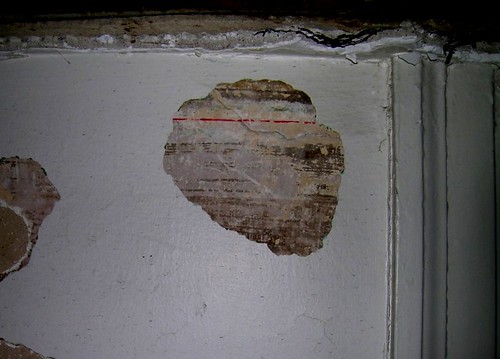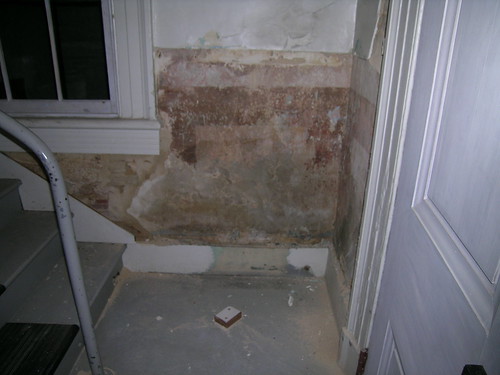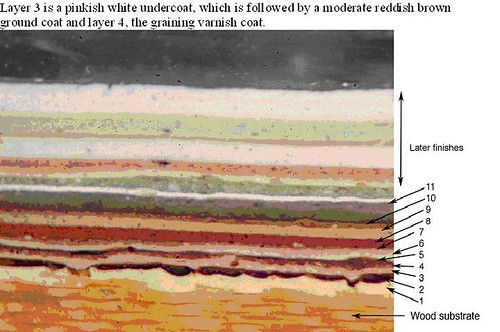By Jeffrey Larry
 The results from the April 3, 2009 paint analysis, conducted by Historic Paint Finishes consultant, Matthew Mosca arrived last month at President Lincoln’s Cottage. Though an excellent photochronology dating back to the Cottage’s first paint layer was obtained, it did confirm that much more study is needed throughout the house to better understand the finishes present during President Lincoln’s time in residence. As mentioned in the previous blog entry, the
The results from the April 3, 2009 paint analysis, conducted by Historic Paint Finishes consultant, Matthew Mosca arrived last month at President Lincoln’s Cottage. Though an excellent photochronology dating back to the Cottage’s first paint layer was obtained, it did confirm that much more study is needed throughout the house to better understand the finishes present during President Lincoln’s time in residence. As mentioned in the previous blog entry, the  paint analysis was performed prior to a plaster repair that could result in the significant loss of original material. The intent was to obtain a record of paint layers and in the process possibly find evidence of early wall paper and/or decorative painting. Previous sampling in other rooms revealed a trompe l’oeil frieze (Figure 1) and painted panels in the vestibule meant to imitate wainscoting (Figure 2). The five samples taken from the wall and trim around the first and second floor stairway showed no evidence of wall paper or decorative painting but did offer new possibilities on Lincoln era wall color and fascinating observations on the baseboard faux graining. Because the wall has never received a paint analysis it was painted the same color as the adjacent walls in the hallway (Benjamin Moore HC-83, Grant Beige). Mosca’s analysis offers the possibility of a mauve brown being present in the early 1860’s. The faux white-oakgraining that was reproduced on the first floor baseboard during the Cottage restoration is based upon a second generation of graining that was exposed in Lincoln’s time. Though there is no reproduction faux graining on the second floor, Mosca’s sample from the baseboard at the top of the stairs shows what appears to be a walnutgraining. (Figure 3) This graining was also applied using a different layering system than that of the first floor.
paint analysis was performed prior to a plaster repair that could result in the significant loss of original material. The intent was to obtain a record of paint layers and in the process possibly find evidence of early wall paper and/or decorative painting. Previous sampling in other rooms revealed a trompe l’oeil frieze (Figure 1) and painted panels in the vestibule meant to imitate wainscoting (Figure 2). The five samples taken from the wall and trim around the first and second floor stairway showed no evidence of wall paper or decorative painting but did offer new possibilities on Lincoln era wall color and fascinating observations on the baseboard faux graining. Because the wall has never received a paint analysis it was painted the same color as the adjacent walls in the hallway (Benjamin Moore HC-83, Grant Beige). Mosca’s analysis offers the possibility of a mauve brown being present in the early 1860’s. The faux white-oakgraining that was reproduced on the first floor baseboard during the Cottage restoration is based upon a second generation of graining that was exposed in Lincoln’s time. Though there is no reproduction faux graining on the second floor, Mosca’s sample from the baseboard at the top of the stairs shows what appears to be a walnutgraining. (Figure 3) This graining was also applied using a different layering system than that of the first floor.
The presentation at President Lincoln’s Cottage focuses on the man and his ideas. The Cottage’s role is to help tell that story, as the context of where Lincoln thought through many of his most important decisions during the Civil War. It was never intended to be a static house museum filled with quarantined relics and rope partitioned rooms. Instead the interpretation is an evolving study of Lincoln’s presidency and an evolving study in how to present that life. This evolving study of serious thought and contemplation is enhanced through the few pieces of furniture and decorative arts placed in select rooms as well as voices of those who met with Lincoln here portrayed through media.
The sense of place is crucial to the stories of Lincoln here. As we learn more about that place, the story may be further enhanced by planning and implementing a comprehensive finishes study of the entire cottage to allow for the selective presentation of thought provoking and appropriate wall and trim finishes.
You may read Part I of this story here: http://lincolncottage.org/plaster-repair-and-paint-analysis-at-president-lincolns-cottage/
